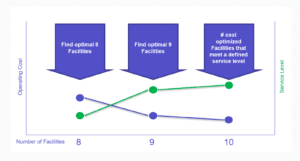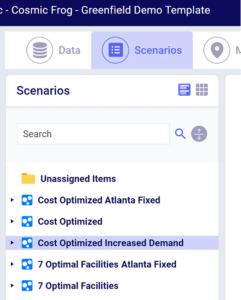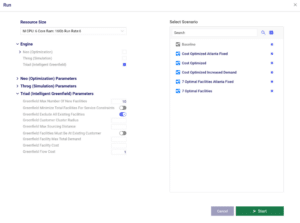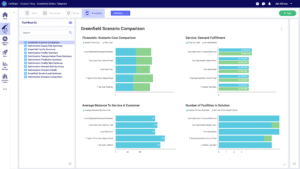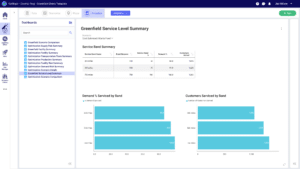Blog
How to Determine Facility Location in Supply Chain Design
PUBLISHED ON:
January 31, 2024
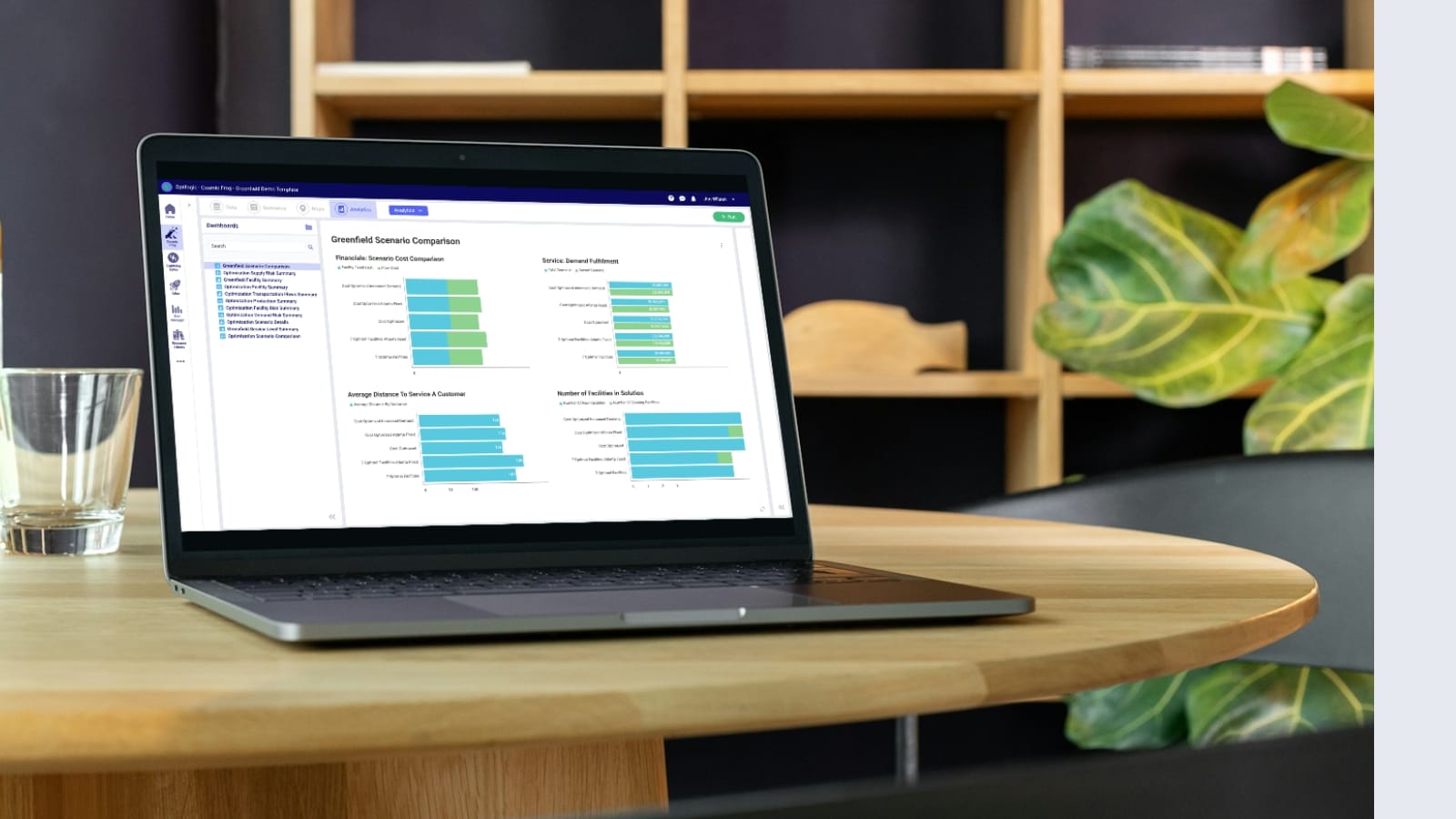
Subscribe to Receive the Latest Supply Chain Design Resources
María Angélica Marchesi
Director of Solution Design
When planning for new facilities or market expansion, optimizing transportation costs, and reducing emissions without sacrificing customer service is a strategic balancing act. The solution? Optilogic’s Intelligent Greenfield analysis.
The Optilogic Cosmic Frog supply chain design solution addresses your facility location questions and empowers you with the data and tools to make smart choices with greenfield analysis software. Read on to learn more about how Cosmic Frog helps you determine facility location in supply chain design.
The Problem with Facility Site Selection
Greenfield analysis helps identify optimal locations for sourcing, production facilities and distribution centers. It streamlines supply chain network design by identifying a central location within easy reach of high-yield customers.
And though it’s an essential factor in any supply chain network, choosing a site location poses many problems and challenges for supply chain designers. When planning for new facilities and market expansions, designers must find candidate facility locations to reduce transportation expenses without sacrificing customer service.
Greenfield analysis helps you determine a viable solution. The following factors influence your facility site selection:
- Demand location
- Service time to customers
- Labor costs
- Population rates
- Existing facility locations
- Transportation costs
The goal for location selection is to expand in a way that makes sense from a business perspective but also considers your constraints and cost optimization.
To achieve this, you need data that’s reliable and usable. You can potentially pull data from many sources, but is that data accurate, and easy to integrate in the decision-making process?
For example, finding reliable information on population data is essential because you need people willing to work at your facility. You also need up-to-date information on transportation route costs because you’ve never had a facility at this potential location, so you don’t know the charges for transportation to and from that site.
Much of the information you need to solve the problem of facility site selection isn’t or can’t be determined within your organization; this data isn’t common knowledge.
Acquiring reliable, relevant, and accurate data is a massive challenge in greenfield analysis and supply chain design. Without quality data, you won’t be able to determine the optimal location for your facilities, and you’ll create faults in your supply chain design.
Why Site Selection Is Important: The Risks of Not Doing It or Doing It Incorrectly
Site selection has a significant impact on efficiency and profitability. It affects how you will serve your customers and differentiate yourself from your competitors. Choosing your facility locations is a strategic decision you can’t take lightly.
Your site selection must balance various factors and costs to contribute to a robust supply chain design. You need to be close enough to your suppliers to receive goods quickly, but you also need to be close to your customers to respond to their needs as efficiently as possible and with better service than your competitors. The tradeoffs of site selection are challenging, and you must know how to balance them from the start. Once you’ve chosen your facility location, changing directions is costly and difficult, if not impossible.
Incorrect or haphazard site selection has many significant consequences for your organization, a few of which we explore below:
- Reduced Customer Satisfaction because you can’t attend to them as quickly as they wanted.
- Lack of Workforce because the location doesn’t have the population density required to support your facility.
- Increased Transportation Costs because you can’t find enough transportation and service to take those products to the customer and receive products in your facilities.
- Delays and Decreased Efficiency when transportation and workforce factors aren’t optimized and balanced against consumer needs.
- Limited Expansion if your site doesn’t allow you to grow and scale efficiently, leading to both immediate impacts for your business and mid- to long-term implications.
- Environmental Risks that occur when you select a location prone to natural disasters or extreme weather events.
- Sustainability Issues that arise when your location is too far from your customers. Longer transportation distances impact C02 emissions, driving you further from your sustainability goals.
Benefits of Tackling Greenfield Analysis with Cosmic Frog
Site location can either fracture your supply chain or facilitate balance for profitability, service, and resilience. Having the right tools empowers you to make the best decision for your organization today that will have lasting impacts into the future.
Optilogic Cosmic Frog allows you to optimize your network footprint to minimize transportation costs, safeguard the supply chain against potential disruptions, and maintain excellent customer service.
Tackling greenfield analysis with Cosmic Frog gives you access to unique benefits you can’t get anywhere else. We explore the advantages of Cosmic Frog below.
Account for Current and Future Fixed Costs
Cosmic Frog empowers you to make greenfield site selections by accounting for various factors, including your current and future fixed and variable costs and the fixed costs. For example, how many facilities do you have, how many might you need in the long term, what investments are needed now and what can you expect that to cost you ten years from now?
Consider Variable Transportation Costs
Transportation and fulfillment costs will change based on the volume of product you move and the distance traveled to and from your facilities. Site selection decisions are not only based on centrality to customers but also on the costs that those decisions influence.
Gain Access to Data Connections and Integration Tools
Cosmic Frog has external data connections and the resources to integrate that information into your decisions. For example, you can access population and data costs already present in the tool and then use it to make location decisions. All the data can be integrated simultaneously, providing instant, streamlined results.
Determine Your Optimal Number of Facilities
Every organization brings different goals, resources, and vision to the table. Cosmic Frog considers your unique priorities to help you understand the optimal number of facilities for your business.
Consider and Prioritize Risk
Risk and resiliency analysis is an often underprioritized yet crucial component of site selection and overarching supply chain design. Cosmic Frog accounts for risk at each of your locations, including the probability of natural disaster, population density of the region, potential for political turmoil, and more.
Cosmic Frog allows you to prioritize and balance all potential risks –– not just cost –– so you can make more informed decisions and create a risk mitigation plan for a better supply chain design.
Understand the Customer’s Perspective and Experience
Cosmic Frog provides detailed data and scenario modeling tools that help you understand the impact from a customer perspective, including the changes on service levels.
Cosmic Frog allows you to simulate endless facility location options, answering your what-if questions for each potential site:
- What is the customer impact on service level, and how quickly can we get to customers?
- Now that we’ve opened this facility and have more capacity, what routes can we take to increase efficiency?
- What assets and transportation do we need to adjust or acquire to reach service and cost goals?
- Where should we position inventory given the new product flows inside the network?
Cosmic Frog delivers a comprehensive understanding of the changes that affect your operations when you open a new facility at any given location.
Simplicity at Every Turn
Supply chain designers want tools that are intuitive and easy to use and implement. Cosmic Frog is built to deliver simplicity at every step in your greenfield analysis.
Simply provide the model with customers and demand to find the optimum facilities from many automatically generated candidates backed by organized, easy-to-interpret data. Press a button, and Cosmic Frog does the work for you.
Get Cost-to-Serve Data
Cosmic Frog delivers valuable cost-to-serve data for each customer. You gain an understanding of the benefit to the customer from a service perspective, and you also have data regarding the cost to get to that customer from the new facility.
If you’re close to the customers, you’ll have faster delivery times and a competitive edge in the market, and you’ll be in a better position to negotiate with transportation and increase the efficiency of your assets.
Cosmic Frog answers the cost-to-serve analysis questions you ask when considering a new facility location:
- If we open this facility, will we have a different service offered to a specific customer because the profit will be affected by this new location?
- Will we have a different customer delivery frequency because we’re closer or farther?
- Are we traveling more miles to most customers, increasing CO2 emissions with this new location? Will we need to add EVs to our fleet to compensate for those effects?
Because Cosmic Frog is cloud-based, you gain accurate, near-instant insights that guide this crucial decision-making process.
You can’t rely on historical data, intuition, or hearsay to determine your facility location. Cosmic Frog empowers you to approach greenfield analysis with data that informs smart, resilient supply chain design.
Cosmic Frog provides real-world solutions for businesses like yours that need fast, accurate, data-driven insights to build and grow.
How to Model Your Greenfield Analysis in Cosmic Frog
Watch this video to see how to model Greenfield site selection in Cosmic Frog:
Following is a summary of how to run a greenfield model. You can use this Cosmic Frog model, available in our model template library, for facility selection from many automatically generated candidates, considering basic capacities, costs, and service levels.
How to use the Intelligent Greenfield model:
- Simply provide the model with Customers and Demand to be able to find the optimum facilities from many automatically generated candidates.
- You may include existing facilities, basic fixed and variables costs, capacities, and service level bands.
- This model is appropriate for high-level greenfield networks to narrow down facility selection for more detailed analysis in network optimization.
- Questions answered: “Number of cost optimized Facilities that meet a defined service level”, “Number of Facilities that meet a defined service level, minimizing weighting”
Example Intelligent Greenfield model:
- Optimal 10 DCs that meet a defined service level
- Optimal 9 Facilities – the service level drops, costs go up
- Optimal 8 Facilities – the tipping point where service level drops off and costs start to increase
- Helps you understand the optimum and explore solutions around the optimum
What data do you need to run Intelligent Greenfield?
To perform greenfield analysis with Optilogic, you’ll need only the following data tables:
- Customers
- Customer Demand – demand record for each customer, multi period. Greenfield will aggregate the demand
- Greenfield Service Bands – the % of demand that must be serviced within each distance band. For example: 50% within 300 MI, 70% within 500 MI, 100% within 750 MI
Next, build scenarios to evaluate
Then, run the scenarios using Cosmic Frog’s Intelligent Greenfield engine
Then, analyze outputs, including average miles to serve customers
Finally, go deeper in your analysis to understand issues like:
- When is the best time to open new and/or close facilities? What capacity should they have?
- How should you design your inventory strategy?
- What are the ideal end-to-end flows?
